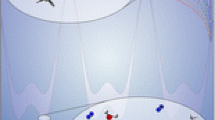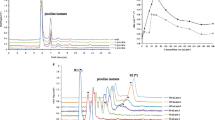Abstract
The location of the most abundant peak of the molecular-ion pattern often differs from the molecular mass published in scientific databases. The location is also distinct from the value expected from average atomic masses. The cause of this phenomenon is a large number of atoms of carbon, sulfur, chlorine, bromine, silicon and boron. This due to the natural isotope abundances of some elements forming organic compounds. A parameter called location of the most abundant peak of an isotopometric cluster (LAPIC) denotes the location of the most abundant (the main) peak of an isotopomeric cluster, which is determined, e.g., by mass spectrometry and can be important for medium- and high-molecular mass compounds. The equations for LAPIC calculation are presented for elements usually observed in organic compounds. The LAPIC with elemental formula helps effectively, e.g., in mass spectra interpretation since the prediction of LAPIC allows the correct connection of the main peak of the investigated ion with the expected ion formula and the mass of the ion considered. This solution can be a substitute for the much more complex method of isotopometric analysis applied in mass spectra interpretation.

Differences of the most abundant peak location (Δ LAPIC C =f(n)) for carbon aggregates C n


Similar content being viewed by others
Notes
Clusters, patterns or bands—well separated (valley = 0%) parts of mass spectra containing several peaks, usually distanced by 1 unit of m/z.
Nominal mass, calculated for molecular ion by using the most abundant isotope of each element, without regard for the mass defect.
Mono-isotopic mass, which refers to the molecular ion peak composed from the most abundant isotopes of the elements, but includes the mass defect
Most abundant mass denotes the mass of the molecular ion peak group calculated from natural isotopes abundance.
Average mass, calculated from the average masses of the elements, weighted for abundance, i.e., the “centroid” of the distribution.
Centroid cluster is the term used by Yergey and denotes the isotopic peaks group forming the cluster.
Isotopic element is the element which occur in two or more natural isotopes.
Agglomerate = aggregate.
References
P\laziak A (1997) Spektrometria masowa związków organicznych (mass spectrometry of organic compounds). Poznań A Mickiewicz University, Poznań, pp 96–101
Beynon JH, Williams AE (1964) Mass and abundance tables for use in mass spectrometry. Elsevier, Amsterdam
McLafferty FW, Tureček F (1993) Interpretation of mass spectra. University Science Books, Mill Valley, pp 19–35
Smith RM, Busch KL (1999) Understanding mass spectra—a basic approach. Wiley, New York, pp 48–62
DeLaeter JR, Heumann KG, Rosman KJR (1991) J Phys Chem Ref Data 20:1327–1337
IUPAC (1991) Pure Appl Chem 63:991–1002
Beynon JH, Saunders RA, Williams AE (1968) The mass spectra of organic molecules. Elsevier, Amsterdam, pp353, 375, 399, 418
Varmuza K, Krenmayr P (1972) Monatsh Chem 103:1055–1063
Hsu CS (1984) Anal Chem 56:1356–1361
doLago CL, Kascheres C (1991) Comput Chem 15:149–155
Gorączko AJ, Szymura JA (1999) Comput Chem 23:135–142
Gorączko AJ, Szymura JA (2000) Comput Chem 24:585–594
Gorączko AJ (2001) J Comput Chem 22:354–365
Gorączko AJ (1998) Comput Chem 22:499–508
Matsuo T, Matsuda H, Katahuse I (1979) Anal Chem 51:1329–1331
Fenselau C (1982) Anal Chem 54:105A–114A
Yergey J, Heller D, Hansen G, Cotter RJ, Fenselau C (1983) Anal Chem 55:353–356
Johnstone RAW, Rose ME (2001) Mass spectrometry for chemists and biochemists, 2nd edn (Polish edition: Spektrometria Mas). PWN, Warsaw, pp 394–399
Author information
Authors and Affiliations
Corresponding author
Rights and permissions
About this article
Cite this article
Gorączko, A.J. Molecular mass and location of the most abundant peak of the molecular ion isotopomeric cluster. J Mol Model 11, 271–277 (2005). https://doi.org/10.1007/s00894-005-0245-x
Received:
Accepted:
Published:
Issue Date:
DOI: https://doi.org/10.1007/s00894-005-0245-x




